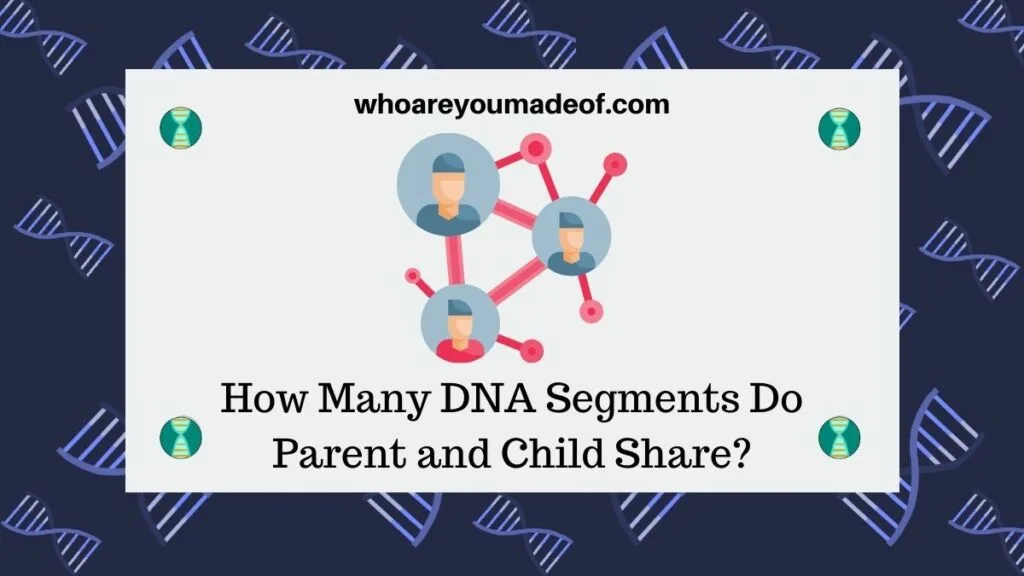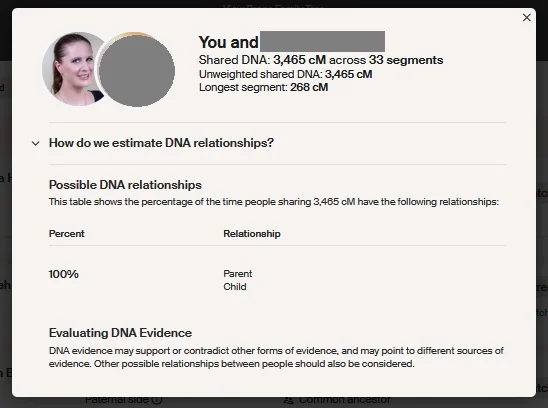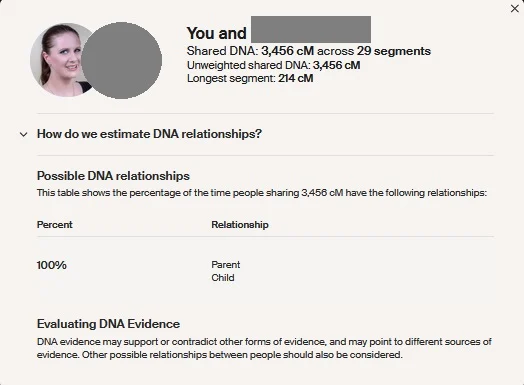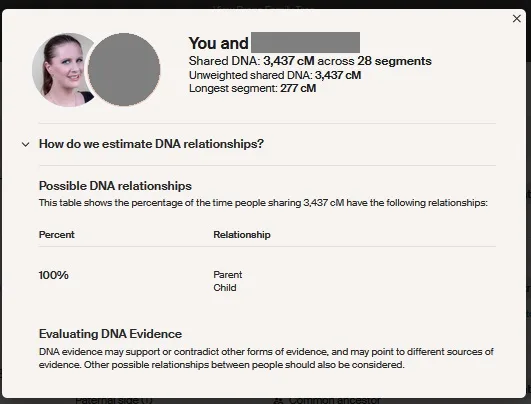Have you wondered how many DNA segments parents and their children usually share? In this post, learn the answer and find out why some might share less than usual.

If you have a parent or child that has taken a DNA test, or you have a DNA match that might be a parent or child, you may have spent some time looking at how much DNA you share. If you do this, you may also see the number of shared DNA segments, and perhaps, the length of those segments.
And naturally, many people wonder if the results that they are seeing are typical or what is typically expected between parents and children.
How to find how many DNA segments you share with your parent or child
Exactly where to look to find how many segments you share with your parent or child will depend on the company that you and your relative used to take your DNA test. On Ancestry DNA, we can only see the total number of shared DNA segments and the length of the longest of those shared segments.
This information is displayed when you click on the blue link that reports the total number of shared centimorgans and percentage of shared DNA.

Other DNA testing companies, such as 23andMe, MyHeritage DNA, and Family Tree DNA, have chromosome browsers where we can examine all of the chromosomes and see exactly how long all of the segments are. I included links each of the company names above directly to articles about how to use their chromosome browsers to view this information.
If you and your parent/child DNA match did not test with the same company, you can upload your DNA to either MyHeritage DNA or Family Tree DNA in order to access their chromosome browser. Alternatively, you could both upload your raw DNA data to a site called Gedmatch, which has free DNA analysis tools.
How many total DNA segments do parents and children share?
Parents and their children technically share 23 DNA segments the length of each entire chromosome. This is because a child inherits one copy of each of their 23 chromosomes from both parents.
You might already know that each of your parents inherited one copy of each of their chromosomes from each of their parents, your grandparents. To create a brand-new chromosome for you to inherit, for example, your mother's two chromosomes went through a process called recombination.
This process took bits and pieces from their two copies of the chromosome that they got from your grandparents. Even though you don't have all of your parents' DNA, you will match them identically at all locations on each chromosome because all of your DNA came from either of their parents.
Even though parents and children share 23 DNA segments, we might not always see this show up on DNA results. Due to a variety of reasons that I will discuss in more depth further on in this article, we might see parents and children share more than 23 DNA segments as DNA matches.
Study of number of detected shared DNA segments for 11 pairs of parent/child relationships
As a small, very non-scientific study, I examined 11 different parent/child relationships on autosomal DNA results. For the chart below, I reported the number of detected shared DNA segments for known parent/child DNA matches.
| Relationship | Number of reported shared DNA segments |
|---|---|
| Mother/daughter | 33 |
| Mother/daughter | 29 |
| Father/daughter | 28 |
| Mother/daughter | 31 |
| Father/daughter | 23 |
| Father/son | 25 |
| Father/son | 28 |
| Father/daughter | 23 |
| Mother/son | 28 |
| Father/son | 27 |
| Father/son | 29 |
| Average number of shared segments | 28 (27.6) |
As you can see, many of the parents and their children share exactly 23 segments, which is the exact amount that they should share from a scientific standpoint. However, we see that the DNA test detected as many as 33 distinct segments.
The average number of DNA segments shared for these 11 different sets of parents and children was 28. These DNA tests were all performed at the same company and were taken between 2016 and 2022, but there did not seem to be any correlation between the number of DNA segments the test was able to detect and the years that the tests were administered.
It should be emphasized again that these were known parent and child pairs and the DNA that the amount of total DNA they shared confirmed their relationships. This means that all of these pairs of parents and children actually shared 23 segments, but the number of segments that the test detected varied slightly.
How long should longest shared DNA segments between parent and child be?
The longest DNA segment shared between a parent and child will be on Chromosome 1, which is usually measured to be 286 centimorgans in length. Chromosome 1 is the largest human chromosome and if we count both copies, it contains about 8% of our DNA.
Each shared DNA segment between a parent and child should cover the entire length of the chromosome. Since each chromosome is of a different length, all shared DNA segments between parents and children will be of a different length.



As you read earlier, the number of DNA segments shared between parents and children that a DNA test detects can vary slightly. This happens because the segments are not actually being detected along the entire length of the chromosome, which leaves small gaps in data.
The segments will show up as identical on both sides of the gap, which will then be reported as two different segments. We see this happen occasionally and it is a result of normal variations in testing.
In other words, it's interesting, but nothing to worry about. If two siblings and a parent take a test, there might be a different in the length of the longest segment, but it does not mean that one child is more related to the parent than the other.
Study of length of DNA segments for 11 pairs of parent/child relationships
After I examined the 11 pairs of parents and children for this post, I prepared the following table that displays the size of the longest DNA segment shared between them. You will note that the size of the longest segment ranges from 214-282 centimorgans (cMs), with the average being about 269.
These are the same parents and children that I looked at for the table in the first part of this article, and they are listed in the same order.
| Relationship | Longest segment length (cMs) |
|---|---|
| Mother/daughter | 268 |
| Mother/daughter | 214 |
| Father/daughter | 277 |
| Mother/daughter | 267 |
| Father/daughter | 268 |
| Father/son | 282 |
| Father/son | 268 |
| Father/daughter | 282 |
| Mother/son | 282 |
| Father/son | 282 |
| Father/son | 264 |
| Average length | 269 (268.55) |
Even though these parent and child DNA matches show a longest segment of a different size, they all showed identical segments the whole length of the Chromosome 1 on a chromosome browser. There was only a small gap in the matches, and the rest of the chromosome was identical, which is normal and what we would expect to see.
Why is there variation in the size of the longest DNA segment shared between parent and children?
There are a few main reasons we might see exactly 23 matching DNA segments of a predictable length shared between parents and their children, or children and their parents. These are all very normal situations that we can expect to see for the foreseeable future of DNA testing.
Missing data
The most common reason we see differences in numbers of DNA segments and lengths is because of missing data when the test is performed. This could be due to the sample quality, among any other number of reasons.
If there is data missing at a particular location of the chromosome, it will not be reported as a match at that location, which creates a small gap in data. It's not a real gap in the chromosome, but it shows up on the DNA results as a gap.
Different testing companies
If two people took their DNA test with different companies and uploaded their DNA to a third site, such as MyHeritage or Gedmatch, for example, we would be more likely to see gaps in data where we wouldn't expect to see them. This is because each DNA testing company tests slightly different SNPs, or locations in our DNA.
Most of the SNPs tested by all companies are the same, but some companies test more SNPS, or some different SNPs, which means that the data will be missing for one of the matches at those locations. This can create those small gaps in data that I have mentioned, and create the appearance of more, shorter DNA segments than there really are.
Different test versions
Autosomal DNA tests were rolled out to the general public beginning about 2007, but it took many years for them to become really popular. People gradually became interested and took tests, which means that everyone in a particular company's database took their test at a different time.
The science, equipment, and technology for analysis has changed significantly, albeit gradually, over the years. This could explain some variation in DNA results between people who tested at different times.
Does the size and number of shared segments between parent and child matter?
No, the size and number of shared DNA segments that we see on DNA results between parents and children doesn't really matter. Examining this information can be interesting and can help us learn about the DNA testing process in general, but it does not have any bearing on our genetic relationship with our parents.
The most important bit of information that we have when it comes to DNA shared between parents and children is the total amount of shared DNA measured as a percentage of about 50% or between 3400-3600 centimorgans. This information tells us that our DNA match is really our parent, which is all we really need to know.
Conclusion
I hope that this article has helped you understand more about how and why parents and children share so few DNA segments, and why it is normal for those segments to occasionally not cover the entire chromosome, as we would normally expect them to do.
If you have any questions about something that you read in this post, or if you would like to share your own observations about the DNA segments that you share with your parent or child, I would love to hear from you in the discussion below.
